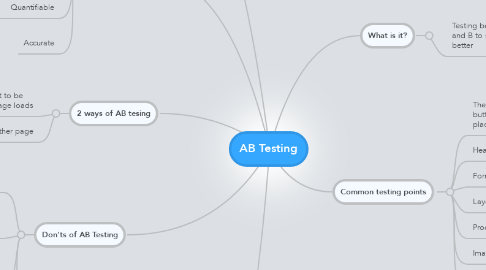AB Testing
por Adeline Tan


1. 2 ways of AB tesing
1.1. Replace the element to be tested before the page loads
1.2. Redirect to another page
2. Don'ts of AB Testing
2.1. Never ever wait to test the variation until after tested the control. Always test both versions simultaneously. Always split traffic between two versions.
2.2. Don’t conclude too early. There is a concept called “statistical confidence” that determines whether the test results are significant
2.3. Don’t surprise regular visitors. Avoid shocking regular visitors, especially because the variations may not ultimately be implemented.
2.4. Don’t let your gut feeling overrule test results. The winners in A/B tests are often surprising or unintuitive.
3. Dos of AB Testing
3.1. Know how long to run a test before giving up.
3.2. Show repeat visitors the same variations.
3.3. Make your A/B test consistent across the whole website.
3.4. Do many A/B tests.
4. Advantages
4.1. Fast
4.1.1. Tt takes very little time to create a modified version of an existing web page that includes a modified item (like a new picture, new copy or other new element) and throw it up on tor site. Then, it’s just a matter of splitting traffic to the two pages.
4.2. Tests reality, not theory
4.2.1. Obtaining real results from real users doing real things
4.3. Quantifiable
4.3.1. A/B web site testing provides actual numbers that can be compared, sliced and diced to evaluate results.
